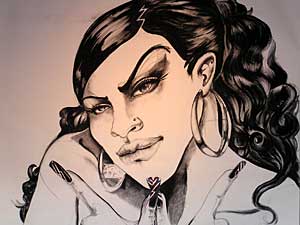June 2, 2005
 |
| "Wepa Woman," by Wanda Ortiz. She is a visual artist based in New York City. Her work focuses on her Puerto Rican identity and the role of Latinas in the United States. (Artwork by Wanda Ortiz ) |
Minneapolis, Minn. — Desdamona is a B-girl, one of the few in the Twin Cities making a living in hip-hop.
"The very first time I performed hip-hop lyrics, I was like about 14 or 15," says Desdamona. "I hadn't been that exposed to hip-hop, but what I'd heard was some Beastie Boys, RUN DMC, and JJ Fad. And I was like, OK, I'm doing this."
A B-girl is a woman who holds a fire for hip-hop. B-girls from around the world are converging on Minneapolis this weekend to talk about their genre and their place in it.
They'll also perform and trade techniques.
Many B-girls talk about hip-hop as something that chose them, a culture they were born into.
Desdamona, however, had to work hard to get her start. Her small town in Iowa wasn't exactly teeming with role models or places to try out her rhymes. And there was the other problem. She's white.
"People told me not to do it, or that as a white woman I'd have to be mainstream, or that I'd have to be a certain kind of hip-hop artist," she says. "And that I don't look like I fit the part."
Desdamona has become a mentor to other young women struggling to find their place in hip-hop. It's a musical genre where male rappers have set the tone. That may intimidate some B-girls.
"I don't feel like, 'Yo, yo.' But that's not what it's about to me," says Ashley Lauren Gold.
Gold, 22, grew up in the suburbs of the Twin Cities. She says she's inspired by hip-hop more than any other music, particularly because of the beat and its message.
She got into poetry when she was about 18, and got her first taste of spoken-word at the Blue Nile, a Minneapolis restaurant that devotes Tuesday nights to poetry slams.
"I saw Desdamona perform and I was like, 'Whoa. Somebody does that. That's actually doable. That's how she makes her living. She writes. And she does poetry,'" Gold says. "I started going to the Blue Nile open mics. I didn't get on the mic for like two years, I was so scared."
Now Gold has a repertoire of poems and songs. Some are political, some are about love, and others are about qualities like respect.
Even though she's got more role models in hip-hop than girls had a decade ago, Gold still feels a little self-conscious about her place in a scene that's most often associated with a certain machismo and an African-American identity.
"I'm a white girl from Minnesota, writing spoken-word and singing the way I sing," she says. "I don't know how that's going to be received or interpreted."
That's because Gold's hip-hop isn't what you typically see on MTV or Black Entertainment Television. For B-girls, hip- hop is about gender, politics, even body image or abortion -- not the stuff of mainstream commercial hip-hop.
Hip-hop feminist scholar Rachel Raimist says that's because the stereotype of hip-hop is different.
"It's just this hypermasculine, black, male violent (image)," Raimist says.
She says the music industry has used those images to sell records and merchandise. But hip-hop didn't start out that way. It blossomed out of the Bronx in the 1970s. Young African-Americans and Puerto Ricans lived in urban decay while New York's wealthier white residents moved to the suburbs.
Raimist describes hip-hop's inception as spontaneous.
"It's a group of kids sitting on the stoop, standing on the street corner, that have a lot to say," Raimist says. "But they don't have tools, expensive things to create art. So they started beating on the sidewalk, beating on a garbage can, telling their stories in poems and in raps, painting it on the walls."
Raimist grew up in New York. She was a latchkey kid who came home every day after school and watched Yo MTV raps on television. Film school came next. She's produced music videos and a full-length documentary about female hip-hop singers.
Then, as an academic, she wrote papers deconstructing popular hip-hop culture. As a mom, she worries about the images of women her daughter sees in rap videos.
Raimist started dreaming about ways to get young girls involved in hip-hop. A coloring book will show them there are lots of ways to be a B-girl.
Hip-hop is everywhere. You can see it in clothing, it affects speech. There are even two universities that focus solely on hip-hop.
It may be one of the most powerful current cultural influences. Kids from Japan to Cuba are rapping, breakdancing, and deejaying. Desdamona says that's OK as long as newcomers, like her, push hip-hop in new directions and add to it.
"It's not a good thing to appropriate something that doesn't belong to you," Desdamona says. "But I think if you contribute, and you are fully a part of that thing, it's good. It expands it."
Part of hip-hop's appeal is its raw form of storytelling. Desdamona says everyone needs to tell their story, and everyone has a unique story to tell.
Perhaps that's the best argument for more women in hip- hop -- helping the world hear more women's stories.







